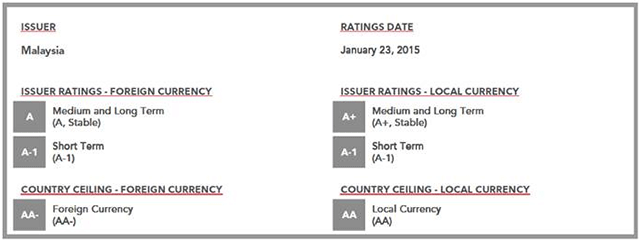
FIRST TIME RATING ACTION
London, January 23, 2015, ARC Ratings SA (ARC), a global rating agency, has assigned a long-term foreign currency issuer rating to the Government of Malaysia (Malaysia) of "A." The agency also assigned a long-term local currency issuer rating of "A+" to Malaysia. The outlook on both ratings is stable. In addition, the agency assigned a foreign currency country ceiling of "AA-" and a local currency country ceiling of "AA" to the country. Short-term sovereign ratings of "A-1" were assigned. All ratings assigned are unsolicited.
RATING RATIONALE
The key rating drivers supporting Malaysia's "A" foreign currency rating are:
1. A strong external position with a history of current account surpluses and low foreign currency indebtedness.
2. An increasingly diverse economic base that has unleashed meaningful growth and has allowed the country to steadily climb to high middle-income status.
3. Strengthening competitiveness that will help Malaysia return to more robust export-led growth in spite of rising domestic costs.
4. A strong financial system as indicated by solid banking sector financials.
5. A record of sound macro management evidenced by Malaysia's achievement of a low inflationary environment, averaging 2.6% inflation pa since 2006. Policy continuity is strong, partly thanks to stable leadership of the country.
The key constraints on Malaysia's credit ratings are:
1. A proclivity toward indebtedness with a large government debt of 54% of GDP and high household debt (87% of GDP at end-September 2014). Sizeable household assets are an ameliorating factor. The government's debt burden is especially large considering its relatively small revenues base, with revenues just over 20% of GDP, and debt to revenues of about 250%. Plans to reduce fiscal deficits and debt are constructive to the ratings.
SUMMARY OF KEY RATING CONSIDERATIONS
(1) ARC's credit assessment is based on the expectation that Malaysia will grow by at least 5% on average over the medium term. GDP growth is forecasted to register 4.5-5.5% in 2015 (revised from 5-6%) due to a more challenging macro environment posed by falling crude oil prices for this energy exporting country. This pace of growth will still allow Malaysia to move towards its goal of high-income status by 2020. A rebalancing of the economy from government-led investment towards a more private-sector led growth model is an objective of the Economic Transformation Program inaugurated in 2010. It is meant to inspire broader-based growth, even as government-linked corporations (GLCs) still dominate economic activity in Malaysia. The economy's dynamic growth performance since the Asian Financial Crisis is a credit strength, while its tendency towards leverage is a weakness that is being addressed by policymakers.
(2) Government debt is close to its self-imposed maximum of 55% of GDP, and set to continue to fall as the government moves towards its objective of a balanced budget by 2020 (against its newly revised estimate of a -3.2% of GDP deficit this year). Built-in institutional strengths, including the persistence of current account fiscal surpluses, and the existence of a sovereign wealth fund, Khazanah Nasional Berhad, are key to the economy's financial and economic stability. The combination of non-explicitly guaranteed contingent liabilities and explicit guarantees by the government for GLCs are estimated to total about 30% of GDP. Large holdings of ringgit - denominated Malaysian Government Securities (MGS) by non-resident investors - around 45% of total at end-December 2014 - are a vulnerability in terms of sudden shifts in investors sentiment especially given prospects for Federal Reserve Bank rate hikes over the medium term, and the current cyclical downturn underway. Adhering to credible fiscal targets will help preserve financial markets confidence.
(3) A continued strong external position over the medium-term, with the current account surplus measuring 5% of GDP on average. Malaysia's history of double-digit current account surpluses has underpinned its solid external situation. In recent years, the surplus has shrunk thanks to reduced global demand, as well as high import demand associated with the large investment projects especially in the transportation sector. Malaysia's sophisticated corporate and banking sectors are eager overseas investors, and this has contributed to the economy's very modest net debtor position. The corporate sector is not overly leveraged (20% of GDP) and the country's large short-term debts are principally intercompany lending. Foreign currency leverage in the economy is moderate. Official foreign exchange reserves of $116 billion at the end of December 2014 provide 8.4 months of cover for imports and are larger than short-term external debt outstanding.
(4) Malaysia's financial sector is a credit strength, with low non-performing loans, sufficient provisions, solid capital ratios and well-managed balance sheet risks. The economic slowdown, falloff in deposit growth, and high household leverage levels are prompting a healthy deleveraging of the economy, while also providing a tailwind to growth.
Continued fiscal restraint is a key consideration for Malaysia's ratings. The government of Prime Minister Najib bin Tun Abdul Razak established a Fiscal Policy Committee in 2013 to manage its transition towards a balanced budget by 2020, from a -3.5% of GDP deficit estimated for 2014, and a -3.2% of GDP deficit programmed for 2015. Policymakers have made several bold fiscal moves, including phasing out oil subsidies (2.2% of GDP) and instituting a Goods & Services Tax (GST) to reduce the government's dependency on petroleum-related revenues. Revenues related to petroleum income are expected to fall to 26.5% of total in 2015 from 30% in 2014 and over 40% in 2009, a trend that should broadly continue - even should oil prices rise -- thanks to the tax reform. The 6% unified GST is set to take effect this April. The current period of low oil prices underlies the urgency of this reform and the need to enact the new tax regime in full force, minimizing exemptions.
ARC's sovereign ratings of Malaysia reflect the expectation that government resolve towards fiscal consolidation will not be substantially diluted despite the current cyclical macro challenges being faced by the economy. The agency's confidence is this policy stance is reinforced by the more credible, but tight, budget for 2015 just announced. The fiscal deficit target was revised to -3.2% of GDP from the original plan of -3.0% of GDP this year, in light of the more adverse macro picture. The budget revision is realistic in ARC's view, and is important to sustaining confidence in fiscal policy; without these changes the deficit would climb to close to -4% of GDP. Measures being implemented sustain current fiscal surpluses, and reduce current expenditure.
Malaysia's economic growth is being affected by low oil prices, reduced lending appetite, slower growth in deposits, weaker demand in China, and general global uncertainties. Financial problems in GLC's -- including 1MDB -- are also dampening investor sentiment due to the contingent liability posed to the sovereign, and the larger question of the growth model relied on by the country. Separately, another rate hike by Bank Negara Malaysia seems unlikely at this juncture given the expectation for inflation developments. Inflation stood at 2.7% in December 2014 and is likely to hover between 2.5-3.5%, taking into account the GST and its impact on moderating consumption.
Notwithstanding these more negative near-term trends, several factors support Malaysia's medium-term growth outlook. Trade cooperation, including the impending establishment of the ASEAN Economic Community and various bilateral trade agreements, as well as Malaysia's partnership in the Trans-Pacific Partnership will help spur more export-led growth and reduce dependency on the trade route with China. Malaysia's premier position as leading sukuk issuer in the world, and the fast growth of its Islamic banking sector also carves out a profitable niche for itself in financial services.
Longer-term competitiveness challenges do exist. Malaysia's commendable progress in moving up the value-added ladder and its goal of achieving high-income status by 2020 (and a per capita GNI surpassing $15,000 from its current level of about $11,000) are likely to be accompanied by rising domestic production costs. Malaysia's commendable success in improving its business environment is critical to sustaining its competitiveness and growth outlook in light of the rising labour cost structure. Supply-side bottlenecks also continue to pose a constraint. Malaysia has a skill shortage of high-skilled workers and the bias towards a labour-intensive industrial production structure.
Malaysia's sovereign wealth fund is an important support factor for the ratings. Khazanah Nasional Berhad is a source of liquidity for the government, cushioning government finances from shocks. It rescued the troubled Malaysian Airlines last summer and could play a role in financing government guarantees or assisting problem enterprises.
ARC's "A+" local currency sovereign rating stance is aligned with our view that sovereigns have much greater flexibility in their national currencies, and also reflects the government's ample access to credit in the local markets. About 97% of the government's debt stock is Ringgit-denominated and the local market is deep.
ARC's "AA-" country ceiling for foreign currency transactions is based on our assessment of transfer and convertibility risk, and considers both the past use of capital controls but also the very pro-investor stance of the government. The country ceiling for local currency transactions of "AA" supports issuers who could achieve a higher credit rating than the government, even though a central government is oftentimes the best credit in a country in local currency.
ARC's sovereign ratings of Malaysia are determined using a methodology and scorecard that looks at the entire economy's balance sheet and liquidity profile, and also does not overemphasize GDP per capita, which in Malaysia's case is low compared to its peer group of countries of similar credit quality. Per capita GDP is often seen as a useful proxy for assessing institutional development. In Malaysia's case, many institutional measurement indicators are very strong, in line with its peers. The agency notes institutional development factors do not predict default. Malaysia has an unblemished payments record, an additional support factor in ARC's Rating assessment of the sovereign.
RATING OUTLOOK AND KEY TURNING POINTS
Malaysia's ratings carry stable outlooks, and take into consideration our expectations that the external current account surplus will widen over the medium term and debt metrics will secularly improve. The stable outlooks also reflect our expectation the economy will reduce its reliance on oil exports, and sustain competitiveness while achieving steady per capita GDP growth.
The trigger for an upgrade would come from a comprehensive improvement in the country's fiscal health, including more robust revenue flows and reduced indebtedness - trends that would position it more in line with peers. Broadening the revenue base, while not increasing the dependency on petroleum-related revenues, would strengthen core government financial health considerably. A steep reduction in contingent liabilities could also provide a trigger for an upgrade, especially as this would likely accompany a change away from the government-inspired growth model. This could come from greater confidence in the improved health of GLCs. Should Malaysia's debt to revenues ratio fall well under 200%, from the current level of 250%, consideration for an upgrade would be appropriate.
Triggers that could prompt a rating downgrade include underperformance on the policy front specifically in the fiscal sphere. A serious deterioration of the financial situations of GLCs would also spark a rating discussion. A sharp and sustained deterioration in Malaysia's external accounts -- the posting of sizable current account deficits (in the magnitude of over -3% of GDP) financed by external debt-creating inflows -- would exert negative pressure on the ratings.
ABOUT ARC RATINGS
ARC is a global ratings agency based in London and Lisbon that partnered with Malaysian Rating Corporation Berhad (MARC) in Malaysia. ARC has also established partnerships with rating agencies in India (CARE Ratings), Brazil (SR Ratings) and South Africa (GCR). ARC is focused on carving out a niche based on the local knowledge and expertise of its partners across the globe. ARC is registered with European Securities and Markets Authority (ESMA). Please visit www.arcratings.com for further details.
THIS DISCLOSURE IS FOR INFORMATION PURPOSES ONLY AND DOES NOT DISPENSE THE READING OF THE RESPECTIVE RATING REPORT.
Contacts:
Alexandra Mousavizadeh,
Managing Director/CEO,
+44 (0) 781 3977 670,
alexandra.mousavizadeh@arcratings.com;
Joan Feldbaum-Vidra,
Head of Sovereigns,
+1 201 574-5783,
joan.vidra@arcratings.com.
© Press Release 2015










